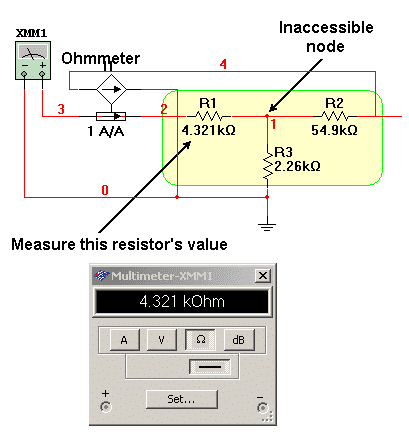source: EDN article
John Dunn -June 12, 2017.
The EDN article provide some hints how to measure embedded resistive network.
Assume that you have a resistive tee network embedded in an impenetrable potting material and you want to make a direct measurement of the value of one of those resistors. Since you can’t access the center node, the other resistor(s) would seem to make that an impossible task, but it can be done.
Figure 1: Embedded Resistance Measurement Problem
To measure the value of R1 in the above sketch, the nominal technique is to sense the current being delivered by the ohmmeter to R1 and to draw an equal value current out of R2 on the other side of the tee. The result will be zero current flowing in R3 and thus zero volts at the inaccessible node. This will make the ohmmeter think it’s seeing R1 alone.
<In an idealized SPICE simulation, the concept looks like the following.
Figure 2: Embedded Resistance Measurement Concept
From a practical standpoint, this concept can be implemented with a current-to-voltage converter and a Howland current pump. The sketch below shows virtual op-amps for the sake of illustrational clarity, but real world op-amps can be brought to bear too.
Figure 3: Embedded Resistance Measurement Implementation
In the above case, the ohmmeter injects 10 nA into R4. That same current is carried by R7 which yields an output from U1 of 100 µV. The Howland circuit places that 100 µV across R12 which results in 10 nA being drawn out of R5. With that current balance, the current through R6 is zero and so is the voltage across R6. The ohmmeter therefore registers the value of R4.
